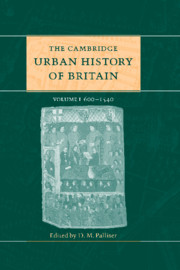Book contents
- Frontmatter
- Part I Introductory
- Part II The early middle ages 600–1300
- Part III The later middle ages 1300–1540
- Part IV Regional surveys
- 21 Regional introduction (England and Wales)
- 22(a) The South-East of England
- (b) The South-West of England
- (c) The Midlands
- (d) East Anglia
- (e) Northern towns
- (f) Wales and the Marches
- 23 Scotland
- Part V Conclusion
- Appendix: Ranking lists of English medieval towns
- Select bibliography
- Index
- References
(b) - The South-West of England
from 22(a) - The South-East of England
Published online by Cambridge University Press: 28 March 2008
- Frontmatter
- Part I Introductory
- Part II The early middle ages 600–1300
- Part III The later middle ages 1300–1540
- Part IV Regional surveys
- 21 Regional introduction (England and Wales)
- 22(a) The South-East of England
- (b) The South-West of England
- (c) The Midlands
- (d) East Anglia
- (e) Northern towns
- (f) Wales and the Marches
- 23 Scotland
- Part V Conclusion
- Appendix: Ranking lists of English medieval towns
- Select bibliography
- Index
- References
Summary
The south-west comprises the modern counties of Cornwall, Devon, Dorset, Somerset and Wiltshire. This region bestrides the divide between highland and lowland England. The majority of the region comprises the older, harder rocks of upland Britain, together with the more acidic soils derived from those rocks, the consequent pastoral farming systems, an ancient bocage landscape and a dispersed pattern of rural settlements. There are few large towns (Map 22.8). The upland moors of Mendip and Exmoor and the granite bosses of Dartmoor and Bodmin Moor add transhumance and mineral exploitation of silver, tin and lead to the economic equation, whilst the long, indented coastline to both the north and south of the peninsula brought opportunities for fishing, coastal trading and links with South Wales, Ireland, north-west France and Iberia. However, the south coast is altogether more sheltered than the north with its steep cliffs and lack of inlets.
In contrast, Wiltshire, Dorset and east Devon are part of the lowland zone with fertile clay vales, chalk and limestone escarpments and plateaux. Soils are more fertile, the climate is drier, mixed farming systems predominate and nucleated village settlements are the norm. However, there were also large areas of lowland heath on the poor sandy soils of south-east Dorset, and extensive down-land pastures on the chalk of Salisbury Plain which could be exploited to feed huge flocks of sheep. Whereas water was in short supply on the downs, the opposite was true in the marshlands of the Somerset Levels which provide a third distinctive local landscape of much richer pastureland.
- Type
- Chapter
- Information
- The Cambridge Urban History of Britain , pp. 583 - 608Publisher: Cambridge University PressPrint publication year: 2000



